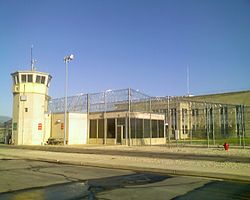Adhasna Prison
This article is incomplete because it is pending further input from participants, or it is a work-in-progress by one author. Please comment on this article's talk page to share your input, comments and questions. Note: To contribute to this article, you may need to seek help from the author(s) of this page. |
 | |
| Location | Arwa province, Charnea |
|---|---|
| Status | Active |
| Security class | High/Maximum |
| Capacity | 5,523 |
| Opened | August 11, 1914 |
| Managed by | Anahad of Justice |
| Director | Jugurtha Bakhta |
Prison 278 Adhasna, better known as Adhasna Prison or simply Big Adha, is a hybrid high-maximum security prison located in the Arwa mountains, 250 kilometers southeast of Ekelhoc in western Charnea. With over 5,000 total inmates, it is the largest prison facility in Charnea by population. Adhasna consists of two sections, a high-security work camp where the majority of prisoners are housed and utilized as a prison labor force for economic activities, as well as a maximum-security section known as "the Pit" built into the subterranean structure of a former mine. The prison employs roughly 11,000 guards and correctional personnel, or over two guards for every inmate in the prison. Adhasna Prison has a reputation for being highly dangerous even in the context of the Charnean prison system, with the highest inmate mortality rate in the system.
History
The site for the prison was selected due to the large subterranean structure of the derelict salt mine, which had been one of the largest in the Arwa mountains before the salt was exhausted. Housing prisoners underground would allow for the prison spaces to be naturally regulated by the temperature moderating effects of the surrounding earth, while the extensive space already excavated underground by the mining activities greatly reduced the cost of excavating such a space. The first inmates in Adhasna were housed in cells cut directly into the rock, with only a gate added to the front to contain the inmate, with facilities at the openings of the tunnels (the adit and exit of the mine) secured them inside and provided mechanical ventilation to the subterranean space. This minor prison was used only for members of organized crime groups which had to be separated from the general prison population to cut them off from their organizations, depriving them of the ability to command their criminal networks from behind bars as well as limiting any help they might be able to recieve in escaping or otherwise subverting the prison system. Adhasna was one of the first prisons in Charnea to be built "in the wilds", in remote locations of the desert landscape isolated enough that a successful escapee without food and water would not be able to survive a journey on foot to the nearest settlement and would die of exposure and dehydration in the desert. As one of the first of this type of prison, it would not be as remote as other wilds prisons and so would remain close enough to the infrastructure of the city of Ekelhoc to the northwest to sustain later expansion to the prison.
Adhasna received a massive expansion, growing from a capacity of 300 to 3,000, in 1950 soon after the conclusion of the Agala War and the resulting social turmoil in the major Charnean urban centers like Agnannet which had exaserbated the weaknesses of the existing Charnean prison system. The expansion included a large new above-ground facility to hold large numbers of prisoners, which consisted of three large cell blocks each having a capacity to hold 1,000 inmates. The thousands of guards needed to staff the prison settled nearby due to the lack of any existing settlement in the vicinity, founding the town of Adhasna outside of the prison complex. In the 1970s, the prison would be expanded again with an additional two 1,000 inmate blocks added on to the complex, bringing its total capacity up to the modern number of 5,523 inmates. This expansion also saw the remodeling of the subterranean maximum-security facility, which coated the rough hewn walls of the prison in concrete, installed modern electric lights, ventilation and plumbing into the tunnels and expanded the capacity by adding some above-ground sections to the maximum security area.